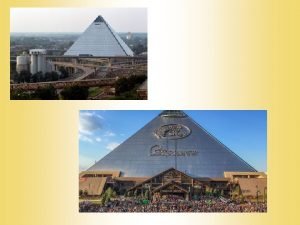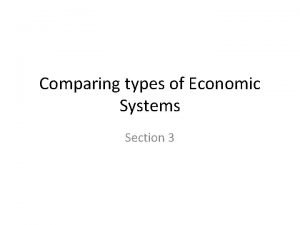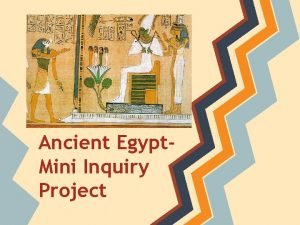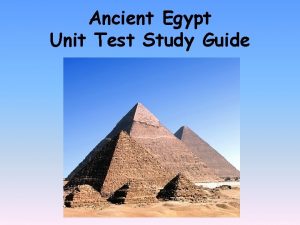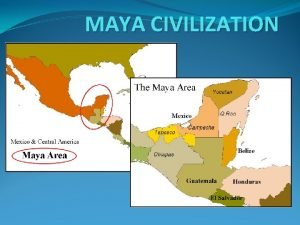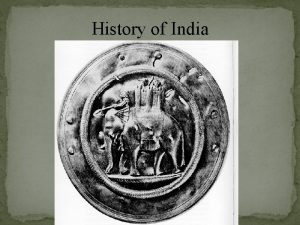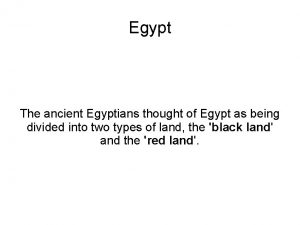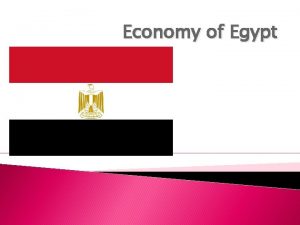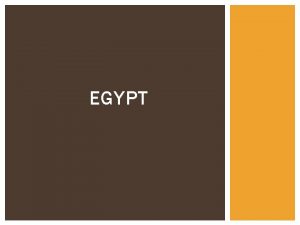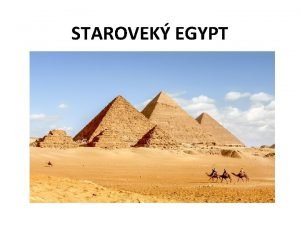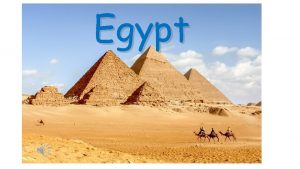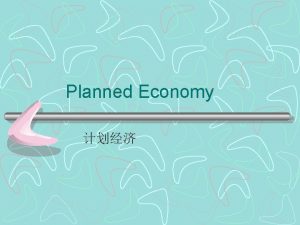EGYPT ECONOMY Egyptians used trade The Egyptians learned













- Slides: 13

EGYPT

ECONOMY • Egyptians used trade. • The Egyptians learned all about how to write and how to do the occupations they needed, as they get older. • Agriculture was the main economic activity. The harvests in Egypt were richer than in most other countries at the time. • The main crops of Ancient Egypt were wheat and barley • There was no typical money system in Egypt. But barley could be defined as a type of money, since it was easy to use as payment. • Crafts were produced • The main exports from Egypt were gold and other minerals, wheat, barley and papyrus sheets.

Society

Society • The ancient Egyptian people were grouped in a hierarchical system • • Pharaon at the top and farmers and slaves at the bottom. Clearly, the groups of people nearest the top of society were the richest and most powerful

The Pharaoh was believed to be a God on earth and had the most power. He was responsible for making laws and keeping order, ensuring that Egypt was not attacked or invaded by enemies and for keeping the Gods happy so that the Nile flooded and there was a good harvest. The Vizier was the Pharaon’s chief advisor and was sometimes also the High Priest. He was responsible for overseeing administration and all official documents had to have his seal of approval. He was also responsible for the supply of food, settling disputes between nobles and the running and protection of the Pharaon’s household. Nobles ruled the regions of Egypt. They were responsible for making local laws and keeping order in their region.

Priests were responsible for keeping the Gods happy. They did not preach to people but spent their time performing rituals and ceremonies to the God of their temple. Scribes were the only people who could read and write and were responsible for keeping records. The ancient Egyptians recorded things such as how much food was produced at harvest time, how many soldiers were in the army, numbers of workers and the number of gifts given to the Gods. Soldiers were responsible for the defence of the country. Many second sons, including those of the Pharaoh often chose to join the army. Soldiers were allowed to share riches captured from enemies and were also rewarded with land for their service to the country.

Craftsmen were skilled workers such as – pottery makers, leatherworkers, sculptors, painters, jewellery makers, shoe makers, tailors. Groups of craftsmen often worked together in workshops. Farmers worked the land of the Pharaon and nobles and were given housing, food and clothes in return. There were no slave markets in Ancient Egypt. Slaves were usually prisoners captured in war. Slaves could be found in the households of the Pharaon and nobles, working in mines and also in temples.

RELIGION • • • Egyptian religion was polytheistic. THE GODS The main god was the God of the Sun: Ra. The gods of ancient Egypt were seen as the lords of creation and custodians of order but also as familiar friends who were interested in helping and guiding the people of the land. The Book of the Dead (set down sometime c. 1550 -1070 BCE. ) is often referred to as `The Ancient Egyptian Bible' which deals with how the soul is to navigate the afterlife.

EGYPTIAN ART AND ARCHITECTURE • The Egyptian art had a stylised ideal of the human figure with body parts sized according to standard proportions. • The poses of these figures are so rigid that scenes from Egyptian art have little sense of movement. • In Egyptian architecture and sculpture, a similar impression of timeless stability is achieved through heavy material (mostly stone).

Architecture • While most Egyptian buildings were composed of sun-baked bricks of Nile clay, the material of choice for monumental buildings was stone. • Egyptian tombs were typically erected in groups. A group of tombs is known as a tomb complex or necropolis.

• Like no other civilization, the Egyptians embraced sculpture on a colossal scale. The extreme case is the Sphinx (a lion-human hybrid), carved from exposed bedrock. Like most structures at Giza, the Sphinx dates to the Old Kingdom period. • . Another common form of colossal Egyptian sculpture was the obelisk, a tall, lightly tapered square pillar with a (four-sided) pyramidal cap.

• Painting and Relief Sculpture • Ancient Egyptian walls, both interior and exterior, were often coated in reliefs and murals. • These flat visual works are typically filled with rows of figures (both deities and humans) and hieroglyphs, along with other Egyptian iconography (traditional images), such as papyrus plants. Detailed narratives were often conveyed via rows of scenes, depicting events both everyday (e. g. farmers harvesting grain) and supernatural (activities of the gods). • c

Ancient Egypt https: //www. youtube. com/watch? v=Kdtg. X 9 ORi. W 4 10 Great Ancient Egypt Mysteries https: //www. youtube. com/watch? v=W 7124 y. KFg 3 U Rosetta stone Champollion https: //www. youtube. com/watch? v=OJwaq 7 ci. Ti. A Rosseta Stone https: //www. youtube. com/watch? v=ZZTFBbtemm. A
 Upper egypt and lower egypt
Upper egypt and lower egypt Economy of ancient egypt
Economy of ancient egypt Economy of ancient egypt
Economy of ancient egypt How did geography affect egypt's economy
How did geography affect egypt's economy What learned about economy
What learned about economy Athens and sparta were both
Athens and sparta were both Olmec timeline
Olmec timeline Indus valley civilization trade and economy
Indus valley civilization trade and economy Trade union rights
Trade union rights Economy of indus valley civilization
Economy of indus valley civilization Trade diversion and trade creation
Trade diversion and trade creation Umich
Umich Trade diversion and trade creation
Trade diversion and trade creation The trade in the trade-to-gdp ratio
The trade in the trade-to-gdp ratio
